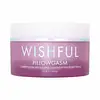What's inside
What's inside
 Key Ingredients
Key Ingredients

No key ingredients
 Benefits
Benefits

 Concerns
Concerns

 Ingredients Side-by-side
Ingredients Side-by-side

Glycerin
HumectantWater
Skin ConditioningTriethylhexanoin
MaskingC14-22 Alcohols
Emulsion StabilisingCetyl Ethylhexanoate
EmollientPentylene Glycol
Skin ConditioningC12-20 Alkyl Glucoside
Emulsifying1,2-Hexanediol
Skin ConditioningPrunus Avium Fruit Extract
Skin ConditioningDaucus Carota Sativa Root Extract
Skin ConditioningAdenosine
Skin ConditioningCannabis Sativa Seed Oil
EmollientGardenia Florida Fruit Extract
Skin ConditioningZingiber Officinale Root Oil
MaskingEthylhexylglycerin
Skin ConditioningButylene Glycol
HumectantGlucose
HumectantPalmitic Acid
EmollientStearic Acid
CleansingMyristic Acid
CleansingArachidic Acid
CleansingDextrin
AbsorbentMagnesium Sulfate
Glycerin, Water, Triethylhexanoin, C14-22 Alcohols, Cetyl Ethylhexanoate, Pentylene Glycol, C12-20 Alkyl Glucoside, 1,2-Hexanediol, Prunus Avium Fruit Extract, Daucus Carota Sativa Root Extract, Adenosine, Cannabis Sativa Seed Oil, Gardenia Florida Fruit Extract, Zingiber Officinale Root Oil, Ethylhexylglycerin, Butylene Glycol, Glucose, Palmitic Acid, Stearic Acid, Myristic Acid, Arachidic Acid, Dextrin, Magnesium Sulfate
Water
Skin ConditioningGlycerin
HumectantNiacinamide
SmoothingCaprylic/Capric Triglyceride
MaskingGlycereth-26
HumectantPhenyl Trimethicone
Skin Conditioning1,2-Hexanediol
Skin ConditioningBehenyl Alcohol
EmollientPolymethylsilsesquioxane
Chlorella Vulgaris Extract
Skin ConditioningGlucose
HumectantCarbomer
Emulsion StabilisingButylene Glycol
HumectantCaprylyl Glycol
EmollientFructooligosaccharides
HumectantFructose
HumectantHippophae Rhamnoides Oil
EmollientTromethamine
BufferingEthylhexylglycerin
Skin ConditioningAcrylates/C10-30 Alkyl Acrylate Crosspolymer
Emulsion StabilisingCitrus Junos Peel Oil
AstringentTocopheryl Acetate
AntioxidantDisodium EDTA
Eclipta Prostrata Extract
Skin ConditioningEclipta Prostrata Leaf Extract
Skin ConditioningCitrus Junos Seed Oil
EmollientMoringa Oleifera Seed Oil
EmollientHydrogenated Lecithin
EmulsifyingCholesterol
EmollientPEG-800
HumectantAscorbic Acid
AntioxidantTocopherol
AntioxidantPolysorbate 20
EmulsifyingCeramide NP
Skin ConditioningLinoleic Acid
CleansingRetinol
Skin ConditioningCitrus Junos Fruit Oil
MaskingBioflavonoids
Skin ConditioningSh-Oligopeptide-1
Skin ConditioningSh-Polypeptide-1
Skin ConditioningSh-Oligopeptide-2
Skin ConditioningSh-Polypeptide-22
Skin ConditioningSh-Polypeptide-45
Skin ConditioningSh-Polypeptide-8
HumectantSh-Polypeptide-9
Skin ConditioningWater, Glycerin, Niacinamide, Caprylic/Capric Triglyceride, Glycereth-26, Phenyl Trimethicone, 1,2-Hexanediol, Behenyl Alcohol, Polymethylsilsesquioxane, Chlorella Vulgaris Extract, Glucose, Carbomer, Butylene Glycol, Caprylyl Glycol, Fructooligosaccharides, Fructose, Hippophae Rhamnoides Oil, Tromethamine, Ethylhexylglycerin, Acrylates/C10-30 Alkyl Acrylate Crosspolymer, Citrus Junos Peel Oil, Tocopheryl Acetate, Disodium EDTA, Eclipta Prostrata Extract, Eclipta Prostrata Leaf Extract, Citrus Junos Seed Oil, Moringa Oleifera Seed Oil, Hydrogenated Lecithin, Cholesterol, PEG-800, Ascorbic Acid, Tocopherol, Polysorbate 20, Ceramide NP, Linoleic Acid, Retinol, Citrus Junos Fruit Oil, Bioflavonoids, Sh-Oligopeptide-1, Sh-Polypeptide-1, Sh-Oligopeptide-2, Sh-Polypeptide-22, Sh-Polypeptide-45, Sh-Polypeptide-8, Sh-Polypeptide-9
 Reviews
Reviews

Ingredients Explained
These ingredients are found in both products.
Ingredients higher up in an ingredient list are typically present in a larger amount.
1,2-Hexanediol is a synthetic liquid and another multi-functional powerhouse.
It is a:
- Humectant, drawing moisture into the skin
- Emollient, helping to soften skin
- Solvent, dispersing and stabilizing formulas
- Preservative booster, enhancing the antimicrobial activity of other preservatives
Butylene Glycol (or BG) is used within cosmetic products for a few different reasons:
Overall, Butylene Glycol is a safe and well-rounded ingredient that works well with other ingredients.
Though this ingredient works well with most skin types, some people with sensitive skin may experience a reaction such as allergic rashes, closed comedones, or itchiness.
Learn more about Butylene GlycolEthylhexylglycerin (we can't pronounce this either) is commonly used as a preservative and skin softener. It is derived from glyceryl.
You might see Ethylhexylglycerin often paired with other preservatives such as phenoxyethanol. Ethylhexylglycerin has been found to increase the effectiveness of these other preservatives.
Glucose is a simple sugar and is the most important source of energy in all organisms.
In skincare, glucose is used to hydrate the skin. It also acts as a prebiotic for our natural biome.
Glucose is hydrating due to its humectant property. As a humectant, glucose draws moisture from the air and from deeper levels in the skin.
Our skin contains many sugars that act as prebiotics and help strengthen our natural microbiome. Having a healthy microbiome helps protect our skin from harmful bacteria and other contaminants.
Studies show glucose may help with fading discoloration and pigmentation. This is because our skin metabolizes glucose into lactic acid. Lactic acid is an AHA that helps exfoliate the top layer of skin.
Learn more about GlucoseGlycerin is already naturally found in your skin. It helps moisturize and protect your skin.
A study from 2016 found glycerin to be more effective as a humectant than AHAs and hyaluronic acid.
As a humectant, it helps the skin stay hydrated by pulling moisture to your skin. The low molecular weight of glycerin allows it to pull moisture into the deeper layers of your skin.
Hydrated skin improves your skin barrier; Your skin barrier helps protect against irritants and bacteria.
Glycerin has also been found to have antimicrobial and antiviral properties. Due to these properties, glycerin is often used in wound and burn treatments.
In cosmetics, glycerin is usually derived from plants such as soybean or palm. However, it can also be sourced from animals, such as tallow or animal fat.
This ingredient is organic, colorless, odorless, and non-toxic.
Glycerin is the name for this ingredient in American English. British English uses Glycerol/Glycerine.
Learn more about GlycerinWater. It's the most common cosmetic ingredient of all. You'll usually see it at the top of ingredient lists, meaning that it makes up the largest part of the product.
So why is it so popular? Water most often acts as a solvent - this means that it helps dissolve other ingredients into the formulation.
You'll also recognize water as that liquid we all need to stay alive. If you see this, drink a glass of water. Stay hydrated!
Learn more about Water